AlexNet—论文分析及复现
AlexNet卷积神经网络是由Alex Krizhevsky等人在2012年的ImagNet图像识别大赛获得冠军的一个卷积神经网络,该网络放到现在相对简单,但也是深度学习不错的卷积神经网络。论文:《ImageNet Classification with Deep Convolutional Neural Networks》
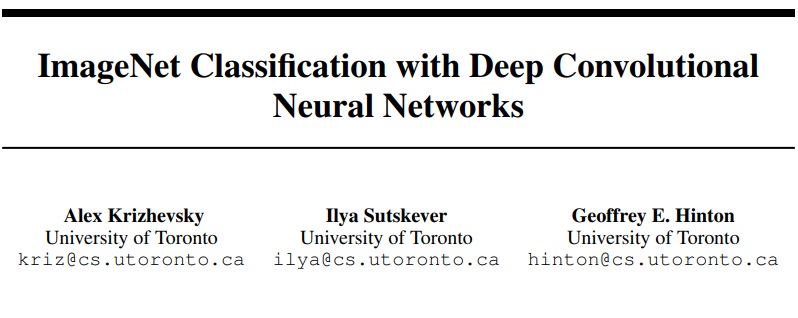
论文结构
Abstruct:简单介绍了AlexNet的结构及其成果
Introduction:神经网络要是有更快的GPU和更大的数据集我们的结果就会得到改善
The Dataset:介绍ILSVRC-2010和ImageNet数据集
The Architecture:ReLU非线性函数介绍、两个GPU进行训练、局部响应归一化、 Overlapping Pooling、整体架构
Reducing Overfitting:对抗过度拟合的方法,数据增强和Dropout
Details of learning:超参数的设置,权重及偏置的初始化
Results:介绍了AlexNet在比赛中获得的成果,性能评估(Qualitative Evaluations):显示预测正确的概率,同一类的图像特征的欧式距离更近
Discussion:结果有了很大的改善,但是在某些方面还是有很多工作要做
AlexNet卷积神经网络的特点
1.非线性激活函数ReLu
在AlexNet出现之前,sigmoid是最为常用的非线性激活函数。sigmoid函数能够把输入的连续实值压缩到0和1之间。但是,它的缺点也非常明显:当神经网络层数过多或输入值非常大或者非常小的时候会出现饱和现象,即这些神经元的梯度接近0,因此存在梯度消失问题。
\]
图像代码:
import numpy as np
import matplotlib.pyplot as plt
def sigmoid(x):
return 1/(1+np.exp(-x))
x=np.arange(-5.0,5.0,0.1)
y=sigmoid(x)
plt.plot(x,y)
plt.ylim(-0.1,1.1)
plt.show()
图像:
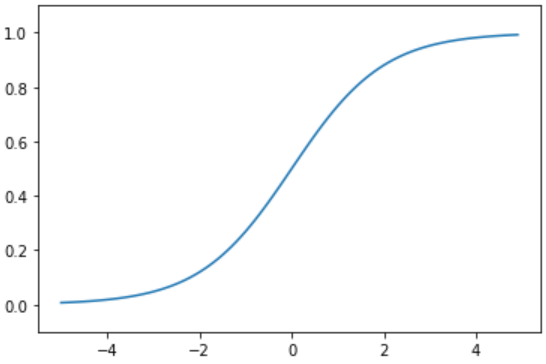
tanh函数(双曲正切激活函数)很像是sigmoid函数的放大版。在实际使用中要略微优于sigmoid函数,因为它解决的中心对称问题。指数的计算复杂,计算成本高。梯度消失(梯度弥散)的特点依旧保留,因为两边的饱和性使得梯度消失,进而难以训练。
\]
图像代码:
import numpy as np
import matplotlib.pyplot as plt
def tanh(x):
return (np.exp(x)-np.exp(-x))/(np.exp(x)+np.exp(-x))
x=np.arange(-5.0,5.0,0.1)
y=tanh(x)
plt.plot(x,y)
plt.show()
图像:
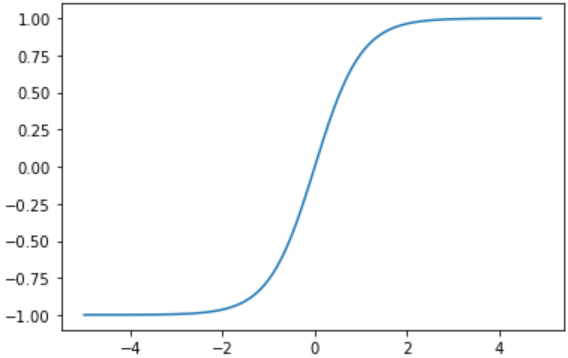
具体来说ReLU的好处有以下几点:
1.可以使神经网络训练更快
相比较于sigmoid和tanh,relu的求导速度更快
2.增加神经网络的非线性
tanh是非线性函数
\]
图像代码:
import numpy as np
import matplotlib.pyplot as plt
def relu(x):
return np.maximum(0,x)
x=np.arange(-5.0,5.0,0.1)
y=relu(x)
plt.plot(x,y)
plt.show()
图像:
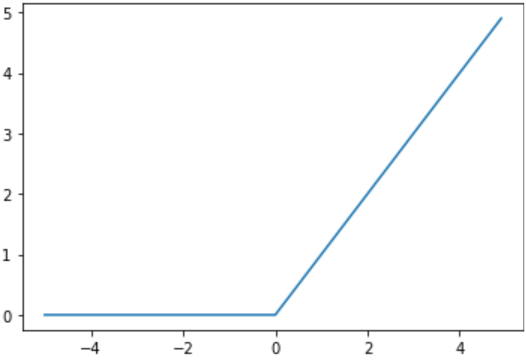
3.使神经网络具有稀疏性
可以使一些神经元输出为0,可以增加网络的稀疏性
4.防止梯度消失
当数值过大或者过小时,sigmoid, tanh导数接近0, 会导致方向传播时梯度消失的问题,relu为非饱和激活函数不存在此问题
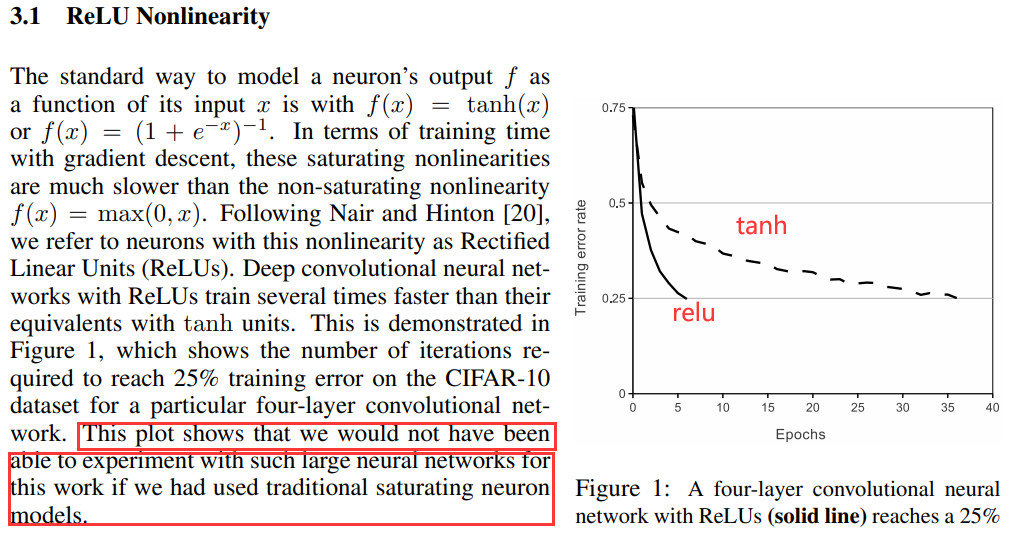
该图表明,如果我们使用传统的饱和神经元模型,我们将无法进行有如此大的神经网络的实验
2.Local Response Normalization(局部响应归一化)
局部响应归一化(local response normalization,LRN)的思想来源于生物学中的“侧抑制”,是指被激活的神经元抑制相邻的神经元。采用LRN的目的是,将数据分布调整到合理的范围内,便于计算处理,从而提高泛化能力。在神经网络中,我们用激活函数将神经元的输出做一个非线性映射,但是tanh和sigmoid这些传统的激活函数的值域都是有范围的,但是ReLU激活函数得到的值域没有一个区间,可以在[ 0 , ∞ ] \lbrack 0,\infty \rbrack[0,∞],所以要对ReLU得到的结果进行归一化。简单理解,就是将利用当前第i ii个kernel的相邻n − 1 n-1n−1个kernel对应( x , y ) (x,y)(x,y) 的值来做归一化。论文中也给出了公式及介绍:

在2015年 Very Deep Convolutional Networks for Large-Scale Image Recognition.提到LRN基本没什么用,故这里不做叙述。

在后来出现的一些CNN架构模型中LRN已不再使用,因为出现了更有说服力的归一化——批量归一化,即BN。
3.两个GPU同时训练
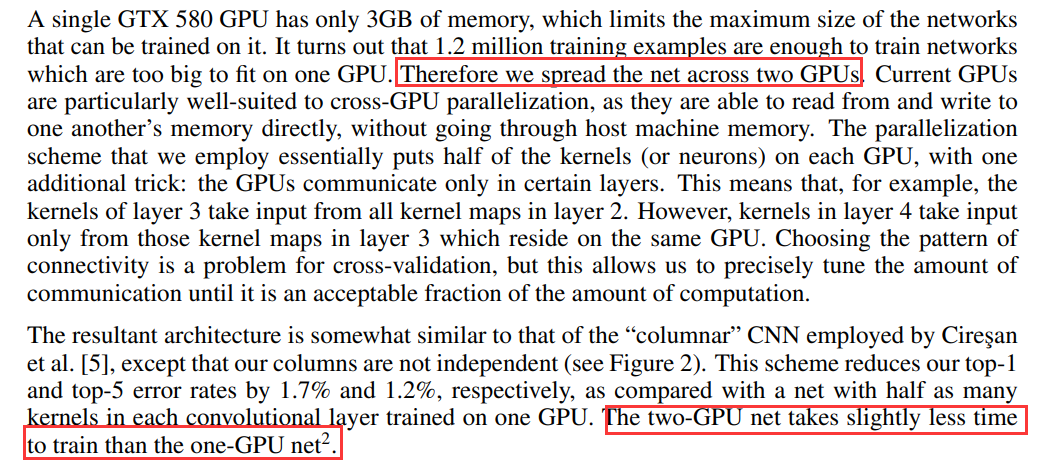
经过上述可知,两 GPU 网络的训练时间比单 GPU 网络略短。
4.Overlapping Pooling(重叠池化)
相对于传统的no-overlapping pooling,采用Overlapping Pooling不仅可以提升预测精度,同时一定程度上可以减缓过拟合

相比于正常池化(步长s=2,窗口z=2) 重叠池化(步长s=2,窗口z=3) 可以减少top-1, top-5分别为0.4% 和0.3%;重叠池化可以避免过拟合。
5.Data Augmentation(数据增强)
论文中提到了两种形式的Data Augmentation
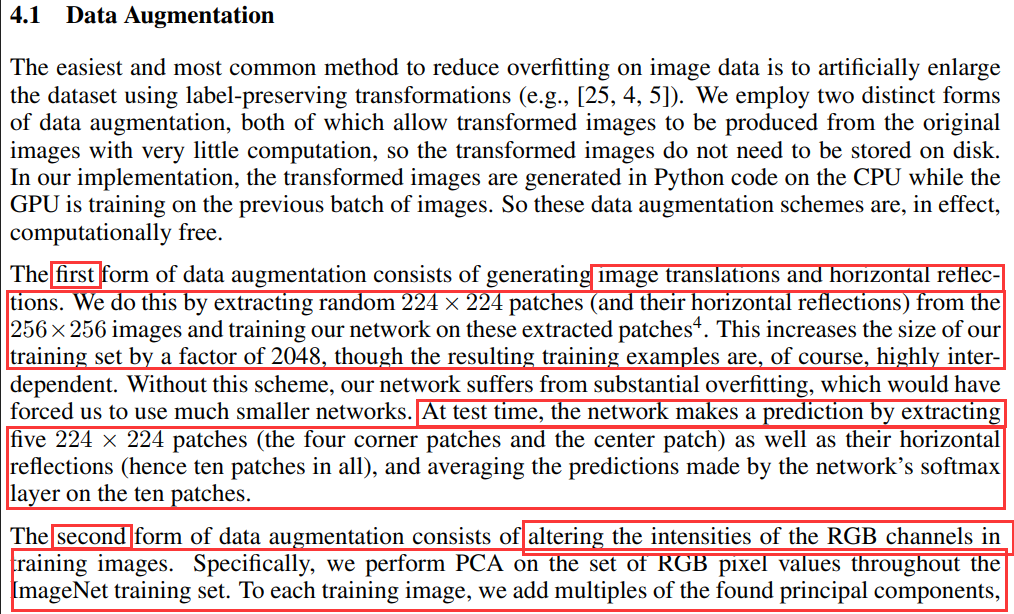

随机地从256 × 256的原始图像中截取224 × 224大小的区域(以及水平翻转的镜像),相当于增加了\(2×(256-224)^{2}=2048\)倍的数据量,大大减轻过拟合,提升泛化能力。在进行测试的时候,取图片的四个角加中间一共5个位置,并进行左右翻转,一共获得10张图片,对他们在softmax层进行10次预测结果并求均值。
对图像的RGB数据进行PCA处理,并对主成分做一个标准差为0.1的高斯扰动,增加一些噪声,可以让错误率再下降1%。其中 pi 和 λi 是 RGB 像素值的 3 × 3 协方差矩阵的第 i 个特征向量和特征值,对于特定训练图像的所有像素,每个 αi 仅绘制一次,直到该图像再次用于训练,此时将重新绘制它。
6.Dropout
dropout可以让模型训练时,随机让网络上的一些节点失效(输出置零),此时的权重值不会更新,但会保存下来,因为这个过程只是对于本次训练。
通常会给dropout设置一个比率为p,也就是说每个节点都有p的概率将会失效,这种技术减少了神经元的复杂协同适应,因为一个神经元不能依赖于特定其他神经元的存在。
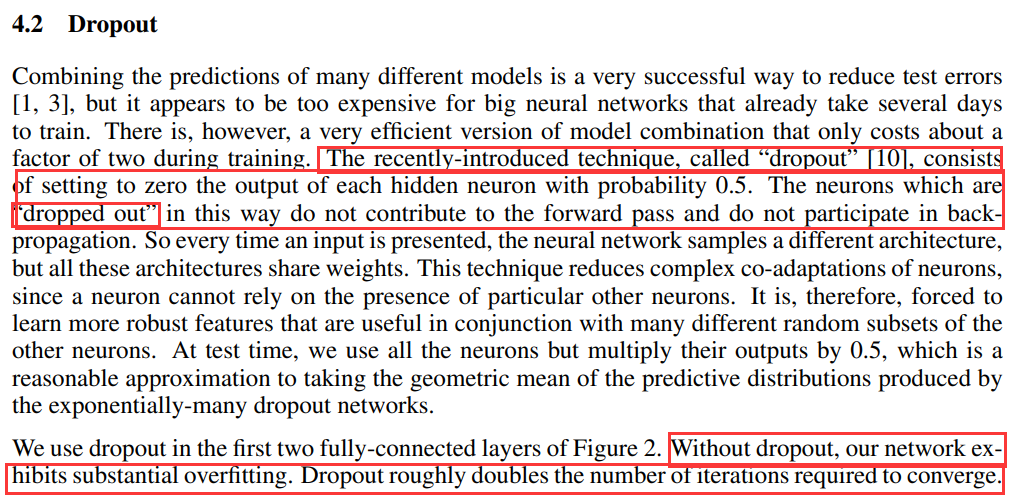
如果没有 dropout,我们的网络将表现出严重的过拟合。
AlexNet网络结构
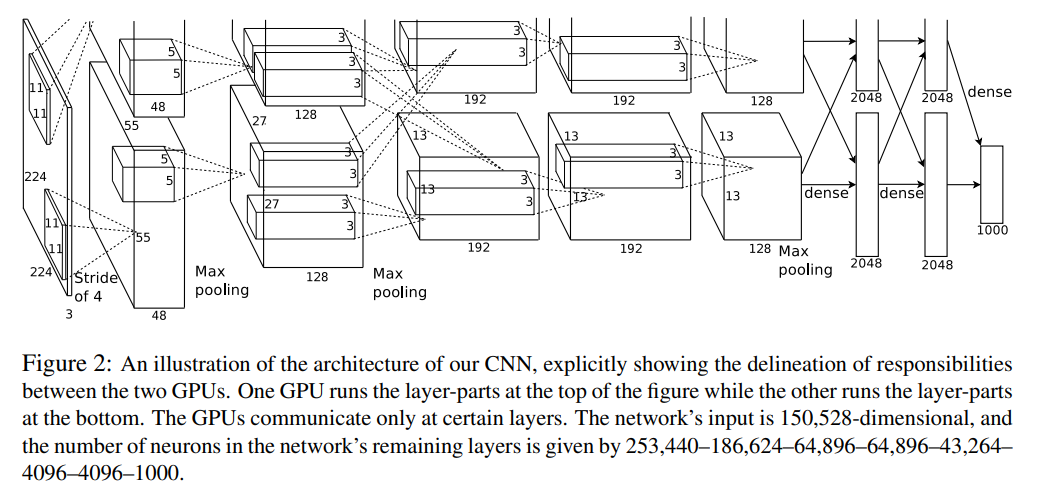
第一层卷积
原论文中,AlexNet的输入图像尺寸是224x224x3。但是实际图像尺寸为227x227x3,具体原因就不深究了,反正224x224x3不能推,227x227x3可以推。
第一个卷积层为11x11x3,即卷积核尺寸为11x11,有96个卷积核,步长为4,卷积层后紧跟ReLU,因此输出的尺寸为 (227-11)/4+1=55,因此其输出的每个特征图为 55x55x96,同时后面经过LRN层处理,尺寸不变。
最大池化层,池化核大小为3x3,步长为2,输出的尺寸为 (55-3)/2+1=27,因此特征图的大小为:27x27x96。由于双gpu处理,故每组数据有27x27x48个特征图,共两组数据,分别在两个gpu中进行运算。
第二层卷积
每组输入的数据为27x27x48,共两组数据,在两个GPU上训练
每组数据都被128个卷积核大小为: 5x5x48进行卷积运算,步长为1,尺寸不会改变,同样紧跟ReLU,和LRN层进行处理
最大池化层,池化核大小为3x3,步长为2,因此输出两组特征图:13x13x128
第三——五层卷积
输入的数据为13x13x128,共两组,分别在两个GPU上
第三层每组数据都被尺寸为 3x3x192的卷积核进行卷积运算,步长为1,加上ReLU,得到两组13x13x192的像素层
第四层经过padding=1填充后,每组数据都被尺寸大小为 3x3x192的卷积核卷积运算,步长为1,加上ReLU,输出两组13x13x192的像素层
第五层经过padding=1填充后,每组数据都被尺寸大小为 3x3x128的卷积核进行卷积运算,步长为1,加上ReLU,输出两组13x13x128的像素层
经过3x3池化窗口,步长为2,池化后输出两组6x6x256的像素层
第六——八层全连接层
第六层:4096 个神经元+ ReLU
第七层:4096个神经元 + ReLU
第八层:1000 个神经元,最后一层为softmax为1000类的概率值
实现代码
采用的数据集为Fashion-MNIST,数据集地址为:Fashion-MNIST
利用tensorflow对AlexNet神经网络进行简易实现
import tensorflow as tf
import numpy as np
# 加载数据
class DataLoader():
def __init__(self):
fashion_mnist = tf.keras.datasets.fashion_mnist
(self.train_images, self.train_labels), (self.test_images, self.test_labels) = fashion_mnist.load_data()
self.train_images = np.expand_dims(self.train_images.astype(np.float32)/255.0,axis=-1)
self.test_images = np.expand_dims(self.test_images.astype(np.float32)/255.0,axis=-1)
self.train_labels = self.train_labels.astype(np.int32)
self.test_labels = self.test_labels.astype(np.int32)
self.num_train, self.num_test = self.train_images.shape[0], self.test_images.shape[0]
def get_batch_train(self, batch_size):
index = np.random.randint(0, np.shape(self.train_images)[0], batch_size)
#need to resize images to (224,224)
resized_images = tf.image.resize_with_pad(self.train_images[index],224,224,)
return resized_images.numpy(), self.train_labels[index]
def get_batch_test(self, batch_size):
index = np.random.randint(0, np.shape(self.test_images)[0], batch_size)
#need to resize images to (224,224)
resized_images = tf.image.resize_with_pad(self.test_images[index],224,224,)
return resized_images.numpy(), self.test_labels[index]
dataLoader = DataLoader()
# 搭建模型
net = tf.keras.models.Sequential([
tf.keras.layers.Conv2D(filters=96,kernel_size=11,strides=4,activation='relu'),
tf.keras.layers.BatchNormalization(),
tf.keras.layers.MaxPool2D(pool_size=3, strides=2),
tf.keras.layers.Conv2D(filters=256,kernel_size=5,padding='same',activation='relu'),
tf.keras.layers.BatchNormalization(),
tf.keras.layers.MaxPool2D(pool_size=3, strides=2),
tf.keras.layers.Conv2D(filters=384,kernel_size=3,padding='same',activation='relu'),
tf.keras.layers.Conv2D(filters=384,kernel_size=3,padding='same',activation='relu'),
tf.keras.layers.Conv2D(filters=256,kernel_size=3,padding='same',activation='relu'),
tf.keras.layers.MaxPool2D(pool_size=3, strides=2),
tf.keras.layers.Flatten(),
tf.keras.layers.Dense(4096,activation='relu'),
tf.keras.layers.Dropout(0.5),
tf.keras.layers.Dense(4096,activation='relu'),
tf.keras.layers.Dropout(0.5),
tf.keras.layers.Dense(10,activation='sigmoid')
])
# 超参数
batch_size = 128
learning_rate = 0.01
momentum=0.0
epoch=20
checkpoint = 20
# 训练
def train_alexnet():
num_iter = dataLoader.num_train//batch_size
for e in range(epoch):
for n in range(num_iter):
x_batch, y_batch = dataLoader.get_batch_train(batch_size)
net.fit(x_batch, y_batch)
if n%checkpoint == 0:
net.save_weights("alexnet_weights.h5")
optimizer = tf.keras.optimizers.SGD(learning_rate=learning_rate, momentum=momentum, nesterov=False)
net.compile(optimizer=optimizer,
loss='sparse_categorical_crossentropy',
metrics=['accuracy'])
train_alexnet()
# 加载并评估
net.load_weights("alexnet_weights.h5")
x_test, y_test = dataLoader.get_batch_test(2000)
net.evaluate(x_test, y_test, verbose=2)
运行中:

比较详细的代码:
# -*- coding=UTF-8 -*-
import tensorflow as tf
# 输入数据
import input_data
mnist = input_data.read_data_sets("/tmp/data/", one_hot=True)
# 定义网络超参数
learning_rate = 0.001
training_iters = 200000
batch_size = 64
display_step = 20
# 定义网络参数
n_input = 784 # 输入的维度
n_classes = 10 # 标签的维度
dropout = 0.8 # Dropout 的概率
# 占位符输入
x = tf.placeholder(tf.types.float32, [None, n_input])
y = tf.placeholder(tf.types.float32, [None, n_classes])
keep_prob = tf.placeholder(tf.types.float32)
# 卷积操作
def conv2d(name, l_input, w, b):
return tf.nn.relu(tf.nn.bias_add( \
tf.nn.conv2d(l_input, w, strides=[1, 1, 1, 1], padding='SAME'),b) \
, name=name)
# 最大下采样操作
def max_pool(name, l_input, k):
return tf.nn.max_pool(l_input, ksize=[1, k, k, 1], \
strides=[1, k, k, 1], padding='SAME', name=name)
# 归一化操作
def norm(name, l_input, lsize=4):
return tf.nn.lrn(l_input, lsize, bias=1.0, alpha=0.001 / 9.0, beta=0.75, name=name)
# 定义整个网络
def alex_net(_X, _weights, _biases, _dropout):
_X = tf.reshape(_X, shape=[-1, 28, 28, 1]) # 向量转为矩阵
# 卷积层
conv1 = conv2d('conv1', _X, _weights['wc1'], _biases['bc1'])
# 下采样层
pool1 = max_pool('pool1', conv1, k=2)
# 归一化层
norm1 = norm('norm1', pool1, lsize=4)
# Dropout
norm1 = tf.nn.dropout(norm1, _dropout)
# 卷积
conv2 = conv2d('conv2', norm1, _weights['wc2'], _biases['bc2'])
# 下采样
pool2 = max_pool('pool2', conv2, k=2)
# 归一化
norm2 = norm('norm2', pool2, lsize=4)
# Dropout
norm2 = tf.nn.dropout(norm2, _dropout)
# 卷积
conv3 = conv2d('conv3', norm2, _weights['wc3'], _biases['bc3'])
# 下采样
pool3 = max_pool('pool3', conv3, k=2)
# 归一化
norm3 = norm('norm3', pool3, lsize=4)
# Dropout
norm3 = tf.nn.dropout(norm3, _dropout)
# 全连接层,先把特征图转为向量
dense1 = tf.reshape(norm3, [-1, _weights['wd1'].get_shape().as_list()[0]])
dense1 = tf.nn.relu(tf.matmul(dense1, _weights['wd1']) + _biases['bd1'], name='fc1')
# 全连接层
dense2 = tf.nn.relu(tf.matmul(dense1, _weights['wd2']) + _biases['bd2'], name='fc2')
# Relu activation
# 网络输出层
out = tf.matmul(dense2, _weights['out']) + _biases['out']
return out
# 存储所有的网络参数
weights = {
'wc1': tf.Variable(tf.random_normal([3, 3, 1, 64])),
'wc2': tf.Variable(tf.random_normal([3, 3, 64, 128])),
'wc3': tf.Variable(tf.random_normal([3, 3, 128, 256])),
'wd1': tf.Variable(tf.random_normal([4*4*256, 1024])),
'wd2': tf.Variable(tf.random_normal([1024, 1024])),
'out': tf.Variable(tf.random_normal([1024, 10]))
}
biases = {
'bc1': tf.Variable(tf.random_normal([64])),
'bc2': tf.Variable(tf.random_normal([128])),
'bc3': tf.Variable(tf.random_normal([256])),
'bd1': tf.Variable(tf.random_normal([1024])),
'bd2': tf.Variable(tf.random_normal([1024])),
'out': tf.Variable(tf.random_normal([n_classes]))
}
# 构建模型
pred = alex_net(x, weights, biases, keep_prob)
# 定义损失函数和学习步骤
cost = tf.reduce_mean(tf.nn.softmax_cross_entropy_with_logits(pred, y))
optimizer = tf.train.AdamOptimizer(learning_rate=learning_rate).minimize(cost)
# 测试网络
correct_pred = tf.equal(tf.argmax(pred,1), tf.argmax(y,1))
accuracy = tf.reduce_mean(tf.cast(correct_pred, tf.float32))
# 初始化所有的共享变量
init = tf.initialize_all_variables()
# 开启一个训练
with tf.Session() as sess:
sess.run(init)
step = 1
# Keep training until reach max iterations
while step * batch_size < training_iters:
batch_xs, batch_ys = mnist.train.next_batch(batch_size)
# 获取批数据
sess.run(optimizer, feed_dict={x: batch_xs, y: batch_ys, keep_prob: dropout})
if step % display_step == 0:
# 计算精度
acc = sess.run(accuracy, feed_dict={x: batch_xs, y: batch_ys, keep_prob: 1.})
# 计算损失值
loss = sess.run(cost, feed_dict={x: batch_xs, y: batch_ys, keep_prob: 1.})
print "Iter " + str(step*batch_size) + ", Minibatch Loss= " + "{:.6f}".format(loss) + ", Training Accuracy= " + "{:.5f}".format(acc)
step += 1
print "Optimization Finished!"
# 计算测试精度
print "Testing Accuracy:", sess.run(accuracy, feed_dict={x: mnist.test.images[:256], y: mnist.test.labels[:256], keep_prob: 1.})
# 以上代码忽略了部分卷积层,全连接层使用了特定的权重。
注:此来源于百度,仅供学习参考
参考文献:
《ImageNet Classification with Deep Convolutional Neural Networks》
本文写于2022年7月27日00:41
AlexNet—论文分析及复现的更多相关文章
- < AlexNet - 论文研读个人笔记 >
Alexnet - 论文研读个人笔记 一.论文架构 摘要: 简要说明了获得成绩.网络架构.技巧特点 1.introduction 领域方向概述 前人模型成绩 本文具体贡献 2.The Dataset ...
- 三维点云去噪无监督学习:ICCV2019论文分析
三维点云去噪无监督学习:ICCV2019论文分析 Total Denoising: Unsupervised Learning of 3D Point Cloud Cleaning 论文链接: htt ...
- DLink 815路由器栈溢出漏洞分析与复现
DLink 815路由器栈溢出漏洞分析与复现 qemu模拟环境搭建 固件下载地址 File DIR-815_FIRMWARE_1.01.ZIP - Firmware for D-link DIR-81 ...
- 【Detection】R-FCN: Object Detection via Region-based Fully Convolutional Networks论文分析
目录 0. Paper link 1. Overview 2. position-sensitive score maps 2.1 Background 2.2 position-sensitive ...
- thinkphp5.0.22远程代码执行漏洞分析及复现
虽然网上已经有几篇公开的漏洞分析文章,但都是针对5.1版本的,而且看起来都比较抽象:我没有深入分析5.1版本,但看了下网上分析5.1版本漏洞的文章,发现虽然POC都是一样的,但它们的漏洞触发原因是不同 ...
- Nexus Repository Manager 3(CVE-2019-7238) 远程代码执行漏洞分析和复现
0x00 漏洞背景 Nexus Repository Manager 3是一款软件仓库,可以用来存储和分发Maven,NuGET等软件源仓库.其3.14.0及之前版本中,存在一处基于OrientDB自 ...
- 【分类】AlexNet论文总结
目录 0. 论文链接 1. 概述 2. 对数据集的处理 3. 网络模型 3.1 ReLU Nonlinearity 3.2 Training on multiple GPUs 3.3 Local Re ...
- Windows RDP的RCE漏洞分析和复现(CVE-2019-0708)
0x00 漏洞描述 Windows系列服务器于2019年5月15号,被爆出高危漏洞,该漏洞影响范围较广如:windows2003.windows2008.windows2008 R2.windows ...
- 【逆向&编程实战】Metasploit安卓载荷运行流程分析_复现meterpreter模块接管shell
/QQ:3496925334 作者:MG193.7 CNBLOG博客号:ALDYS4 未经许可,禁止转载/ 关于metasploit的安卓模块,前几次的博客我已经写了相应的分析和工具 [Android ...
随机推荐
- ansible的介绍与安装
ansible是在远程主机上批量执行命令或者脚本的一个工具 epel源:一个第三方的yum源(阿里巴巴开源镜像站:https://opsx.alibaba.com/mirror?lang=zh-CN) ...
- uniapp中IOS安卓热更新和整包更新app更新
在App.vue中 onLaunch: function() { console.log('App Launch'); // #ifdef APP-PLUS this.getVersion(); // ...
- mySql in 语句查询优化
有这么一条sql UPDATE product set BuyerCount =BuyerCount+1 where ProductId in( SELECT ProductId from order ...
- OPRF
在PSI中经常用到OPRF技术,现在系统学习一下. PRF Pseudo Random Function,伪随机函数,主要就是用来产生为伪随机数的. 伪随机数 什么伪随机数? 伪随机数是用确定性的算法 ...
- 【Azure Developer】使用Azure PubSub服务示例代码时候遇见了.NET 6.0的代码转换问题
问题描述 当本地环境中安装.NET 6.0后,用指令 dotnet new web 或 dotnet new console 生成的项目,使用的都是新模板生成的Program.cs文件.里面去掉了n ...
- 好客租房27-state的基本使用
5.1state的基本使用 状态:数据 是组件内部的私有数据 只能再组件内部使用 state的值是对象 表示一个组件中可以有多个数据 获取数据 this.state //导入react imp ...
- Python数据分析--Numpy常用函数介绍(5)--Numpy中的相关性函数
摘要:NumPy中包含大量的函数,这些函数的设计初衷是能更方便地使用,掌握解这些函数,可以提升自己的工作效率.这些函数包括数组元素的选取和多项式运算等.下面通过实例进行详细了解. 前述通过对某公司股票 ...
- Kubernetes Job Controller 原理和源码分析(二)
概述程序入口Job controller 的创建Controller 对象NewController()podControlEventHandlerJob AddFunc DeleteFuncJob ...
- MySQL数据库5
内容概要 pyhton操作MySQL SQL注入问题 修改表SQL语句补充 视图.触发器.储存过程 事务 流程控制 函数 索引与慢查询优化 内容详情 pyhton操作MySQL python中支持操作 ...
- 五分钟搞懂POM设计模式
转载请注明出处️ 作者:IT小学生蔡坨坨 原文链接:五分钟搞懂POM设计模式 大家好,我是IT小学生蔡坨坨. 今天,我们来聊聊Web UI自动化测试中的POM设计模式. 为什么要用POM设计模式 前期 ...
